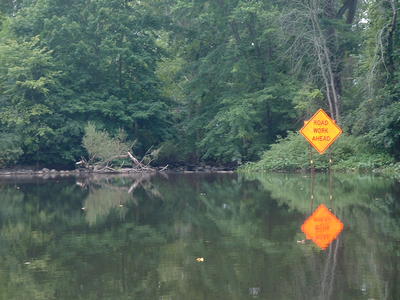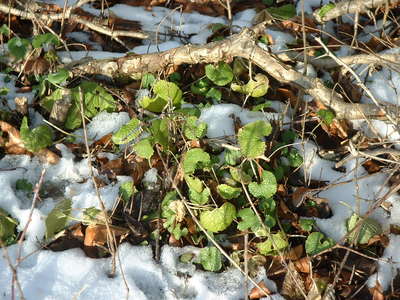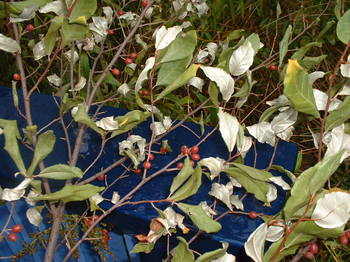Wildcrafting: Is foraging harmful? An ethical overview

My Rhodesian Ridgeback Nala knows that the mulberries that fall on the sidewalk are fair game.
Linda Diane Feldt | Contributor
Recently I wrote part one in a series about how to make foraging safer for people. Part two is about environmental concerns, and some of the ethical concerns about wild harvesting.
There is nothing more natural than finding food, harvesting it and using it. People who didn’t do that died out long ago. But we’ve recently — in the last 100 years or so — made it more complicated.Â
Our parks and the natural areas have rules about picking things and eating them. Mostly you can pick berries and sometimes greens, but no digging is allowed and many edibles, as well as flowers, are now protected or the areas they grow in are protected. So the first ethical guideline is to obtain permission — from the landowner or from the city or public agency that is responsible for the park. You can also read up on endangered plants and avoid picking and using them unless they are cultivated.

Look for signs, even if they seem out of place. Private property is often marked and parks will have rules you must follow. This was a sign in place for river traffic, when the Delhi Bridge was still under construction.
Linda Diane Feldt | Contributor
Act legally and responsibly, and learn the rules. There are gray areas. Fruit trees are a great example. If I find a tree bearing fruit that hangs over the sidewalk or falls on the street it's fair game, but if I can see or know that the tree owner is collecting the fruit I’ll leave it alone. Nearly everyone will say yes if you ask to pick it if they aren’t planning to harvest themselves. You can also offer to share the bounty. I’ve gotten permission to tap maple trees by offering back a bit of syrup.
I can often exchange information about what valuable plants people have and how to use them for access to the plants. And of course that gift lasts for multiple seasons.
We’re more crowded than we ever used to be. And the plants may have less area to grow. So the rule of thumb is to take only 1/3 or less of a particular plant. But this is just a very broad guideline. In some areas, taking that much could devastate an area. There are so many factors to consider. Will other people be harvesting? Is erosion a concern? Are the animals or insects that depend on that plant in any danger or experiencing stress or scarcity? Is it a plant that will rejuvenate well?Â
For a berry plant like black raspberries, you are certainly entitled to pick all the ripe berries you can find. More will ripen for the next person. But leave the plant intact and healthy for that next person. Then again, if it is an invasive like garlic mustard or autumn olive you might want to take as much as possible and also wipe out the plant entirely. Be thoughtful and think holistically.

With an invasive like garlic mustard, take as much as you can, even if you aren't going to use it all. The responsible thing is to remove it by the roots to destroy the plant. You can harvest this pretty much anywhere, all times of the year, without first obtaining permission. Of course you need to ask if you want to trespass in the process. This is garlic mustard growing happily in the winter.
Linda Diane Feldt | Contributor
It is important to look at the area from a greater perspective as well as considering what is happening right in front of you. The ethical principle is to harvest sustainably, aware of the impact your collection will have in the short term, the long term, on the immediate area and on the others who depend on it for food.
Of course this principle is also combined with the importance to only harvest what you will use. If you don’t have the time, the patience, or the ability to process and use what you harvest, don’t pick it in the first place.
I’ve also seen people new to foraging commit two errors. One is to trample other valuable plants in order to get to the one they want. We need to tread lightly. The second error is to destroy the whole plant when only a part is used. For example, with some perennials you can dig the root and replace part of it to continue to grow. If you are harvesting leaves, the plant doesn’t need to be uprooted at all. If possible, pick only the portion of the plant you will use.

Autumn Olive is another example of an invasive plant, which is abundant in its berry production. Harvesting as many berries as is possible will keep that many more seeds out of production. It is a valuable food source for many birds, but I rarely see a bush stripped clean even mid-winter. Some might argue for the birds, but this is a species that is better off being minimized in this area.
Linda Diane Feldt | Contributor
The next point should be obvious, but it is actually one of the more difficult ones to convince people of. Keep it simple. Many of the prized exotic and endangered plants are not even needed. There are simple, easy to find substitutes that can be used. Use what is abundant and local first.
When you are out foraging, and also preparing herbs and plants, you can be an example of safe and ethical harvesting for others. If people are observing you, what do you want them to learn?
Be generous. Sharing your finds with others inspires them to also go out and harvest. Scarcity is more perception than reality. Wild mushrooms may be the exception, but feeling protective and secretive about your harvesting spots generally doesn’t help people to start harvesting, and makes it an exclusive and hostile, secretive thing rather than an opportunity for community sharing and learning together.
By sharing information, discoveries, recipes and more you can help teach other people about the value of foraging. And hopefully also impart some of the ethical considerations.
Don’t be overconfident and don’t take unnecessary risks. Gently expand your area of expertise, but don’t put yourself or other people at risk by trying plants you don’t really know are safe or you can’t positively identify.
Be aware of your competition. The bees will also need the flowers you pick. The hummingbirds may be dependent on the plant you want to eat. The goldfinches and I are in disagreement about Echinacea seeds. I want them scattered to grow more plants, they want to devour them all. Waiting even a few days after blooming to harvest bee balm flowers will let the bees have them first, a good compromise. The more you know about a plant, the more you know about who depends on that plant for survival and you can learn ways to stop it from being a competition and find ways to accommodate everyone's needs. And there are compromises. If you stick to the path, the birds and insects and other animals will generally find plenty deeper into the woods or fields.
Communicate with the plants you want to harvest. Now, that can sound a bit nutty but it can also be very practical. Plants don’t talk. But they do communicate. You can tell if a plant is stressed by looking to see its vibrancy, great color and if it's keeping pace with its neighbors (premature leaf drop or being ahead or behind the season are not good signs). You don’t want to eat stressed and unhealthy plants, which isn’t something that is hidden. You can also trust your instincts when balanced with knowledge. If you see a fruit and your response is “Wow! Yes!,” that is worth noting and responding to. If you instead have an initial negative reaction, pay attention to that as well. There may be unconscious communication from the plant to stay away. It may be only later that you realize there are signs of recent spraying, mold, or maybe even a dead and decaying animal nearby.
Wild harvesting is not inherently dangerous to the plants, the environment, wild animals or to people. We can make it dangerous, we can create conflicts and behave poorly and thoughtlessly. In balance, most foragers develop great caring for the environment and act on that concern in positive ways. Having more people out and about in nature has so many benefits, positively affecting our overall health and spiritual lives, stimulating mental awareness and satisfying our innate seeking behavior. And creating people who care more about the world around us.
Be thoughtful, but certainly the most important ethic is to enjoy yourself, have fun, and share that positive experience with other people, especially kids.
Linda Diane Feldt is a local Holistic Health Practitioner, writer, and teacher. You can follow her on twitter, visit her web site, or reach her directly ldfeldt (at) holistic wisdom.org. Her cookbook “Loving Life and Dark Green Leafy Vegetables” is also available locally at Indigo Forest, Crazy Wisdom Bookstore and Tea Room, Nicola’s Books, and Morgan and York.


Comments
Hector
Mon, Aug 30, 2010 : 3:36 p.m.
Autumn olive fruit is very nutritious. High in vitamins and anti-oxidants. It has been tested by the USDA Beltsville. It's other claim to fame is its nitrogen fixing ability. The foliage is about as nutritious as alfalfa and it fixes enough nitrogen to feed adjoining plants and trees. We have used them extensively as a nurse shrub in our orchard. It is invasive, but mowing keeps it out of places where it is not wanted. Hector Black, zone 6 Middle TN
michiganexpats.com
Mon, Aug 30, 2010 : 2:48 p.m.
In many ways, this is similar to the fisherman's code before fishing was regulated. Responsibility and respect for the habitat is important.